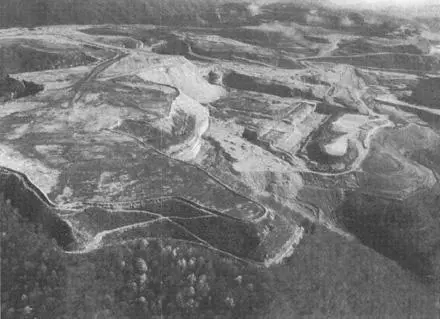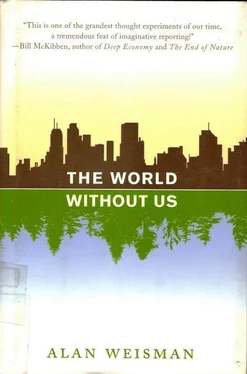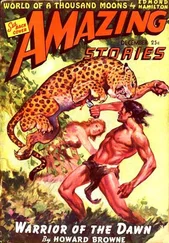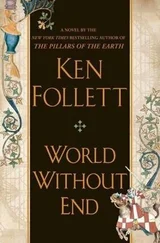Today, the few thousand that remain are protected, and the only legally harvested wild qiviut comes from wisps found clinging to tundra vegetation, a laborious undertaking that contributes to the $400 price a sweater made from ultrasoft musk ox fleece can command. If the Arctic becomes progressively balmier, however, qiviut may again be this species’ undoing—although, if humans (or at least their noisy carbon emitters) vanished, the musk ox might still get a break from the heat.
If too much of the permafrost itself is undone, it would thaw deeply buried ice that forms crystalline cages around methane molecules. An estimated 400 billion tons of these frozen methane deposits, known as clathrates, lie a few thousand feet beneath the tundra, and even more are found beneath the world’s oceans. All that very-deep-freeze natural gas, estimated to at least equal all known conventional gas and oil reserves, is both enticing and frightening. Because it’s so dispersed, no one has come up with an economical way to mine it. Because there’s so much of it, if it all floats away once the ice cages melt, that much methane might ratchet global warming to levels unknown since the Permian extinction, 250 million years ago.
For now, until something cheaper and cleaner comes along, the only other still-abundant source of fossil fuel we can count on will leave an even bigger signature on the surface than a mere open-pit diamond mine—or copper, iron, or uranium mines, for that matter. Long after those fill with water or with their own windblown tailings, this one is good to endure a few more million years.
“It can only be appreciated—if that’s the word—from above,” says Susan Lapis, a cheerful redheaded pilot who volunteers for the North Carolina-based nonprofit organization SouthWings. From the window of her single-engine, red, white, and blue Cessna 182, you look down at a world sliced as flat as any mile-high ice sheet ever managed. Only this time, the glacier was us, and the world was once West Virginia.
Or Virginia, Kentucky, or Tennessee, because several million acres of Appalachia in all those states now look identically amputated, sheared away by coal companies that, in the 1970s, discovered a trick cheaper than tunneling or even strip-mining: just pulverize the entire top third of a mountain, sluice out the coal with a few million gallons of water, push what’s left over the side, and blast again.
Not even the Amazon laid bare rivals the shock of this planar void. In every direction, it’s simply gone. Grids of white dots—the next round of dynamite charges—provide the only remaining texture on naked plateaus that were once vertical, verdant heights. Demand for coal has been so ferocious—100 tons extracted every two seconds—that often there hasn’t even been time to log here: oaks, hickories, magnolias, and black cherry hardwoods have been bulldozed into the hollows, to be buried by a former Allegheny mountain of rubble—“the overburden.”
In West Virginia alone, 1,000 miles of streams flowing through those hollows have been buried as well. Water finds a way, of course, but as it pushes through tailings for the next several thousand years, it will emerge with more than the normal concentration of heavy metals. Yet even given projected world energy demand, industry geologists—and industry opponents—believe that deposits in the United States, China, and Australia contain about 600 years’ worth of coal. By mining this way, they can get at much more of it, much faster.

Mountaintop removal, West Virginia.
PHOTO BY V. STOCKMAN, OVEC/SOUTHWINGS.
If energy-drunk humans were gone tomorrow, all that coal would remain in the ground until the end of time on Earth. If we’re around at least a few more decades, however, a lot of it won’t, because we’ll dig it up and burn it. But if an unlikely plan goes extremely well, one of coal power’s most problematic by-products may end up sealed away once more beneath the surface, creating yet another human legacy to the far future.
The by-product is carbon dioxide, which a burgeoning consensus of humanity agrees probably should not be stored in the atmosphere. The plan, which is attracting growing attention—especially from industry boosters of an oxymoron born of recombinant public relations: “clean coal”—is to capture CO 2before it leaves the smokestack of coal-fired electrical plants, stuff it underground, and keep it there. Forever.
It would work like this: Pressurized CO 2would be injected into saline aquifers that, in much of the world, lie under impermeable caprock at depths of 1,000 to 8,000 feet. There, supposedly, the CO 2would go into solution, forming mild carbonic acid—like salty Perrier. Gradually, the carbonic acid would react with surrounding rocks, which would dissolve and slowly precipitate out as dolomite and limestone, locking the greenhouse gas in stone.
Each year since 1996, Norway’s Statoil has sequestered 1 million tons of carbon dioxide in a saline formation under the North Sea. In Alberta, CO 2is being sequestered in abandoned gas wells. Back in the 1970s, then federal attorney David Hawkins joined in discussions with semioticians about how people 10,000 years hence might be alerted to buried nuclear wastes at what today is New Mexico’s WIPP site. Now, as director of the Climate Center of the Natural Resources Defense Council, he contemplates how to tell the future not to drill into sequestered reservoirs of invisible gases we might sweep under the rug, lest they unexpectedly burp to the surface.
Aside from the expense of drilling enough holes to capture, pressurize, and inject the CO 2from every industrial and power plant on Earth, a big concern is that hard-to-detect leaks of even 1/10 of 1 percent would eventually add up to the amount we’re pumping into the air today—and the future wouldn’t realize it. But given the choice, Hawkins would rather try containing carbon than plutonium.
“We know that nature can engineer leak-free gas storage: there’s been methane trapped for millions of years. The question is, can humans?”
3. Archaeological Interlude
We tear down mountains, and unwittingly build hills.
Forty minutes northeast of the city of Flores on northern Guatemala’s Lake Petén Ixta, a paved tourist road arrives at the ruins of Tikal, the largest Classic Mayan site, its white temples rising 230 feet above the jungle floor.
In the opposite direction, until recent improvements halved travel time, the rutted road southwest from Flores took three miserable hours, ending at the scruffy outpost of Sayaxché, where an army machine gun placement perched atop a Mayan pyramid.
Sayaxché is on the Río Pasión—the Passion River—which lolls through the western Petén province to the confluence of the rivers Usamacinta and Salinas, together forming Guatemala’s border with Mexico. The Pasión was once a major trade route for jade, fine pottery, quetzal feathers, and jaguar skins. More recently, commerce includes contraband mahogany and cedar logs, opium from Guatemalan highland poppies, and looted Mayan artifacts. During the early 1990s, motor-driven wooden launches on a sluggish Pasión tributary, the Riochuelo Petexbatún, also carried quantities of two modest items that in the Petén are veritable luxuries: corrugated zinc roofing and cases of Spam.
Both were destined for the base camp that Vanderbilt University’s Arthur Demarest built in a jungle clearing out of mahogany planks for one of the biggest archaeological excavations in history, to solve one of our biggest mysteries: the disappearance of Mayan civilization.
Читать дальше












